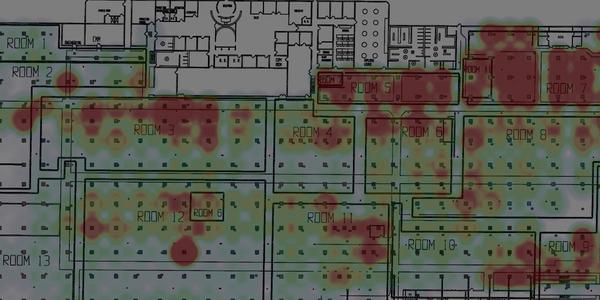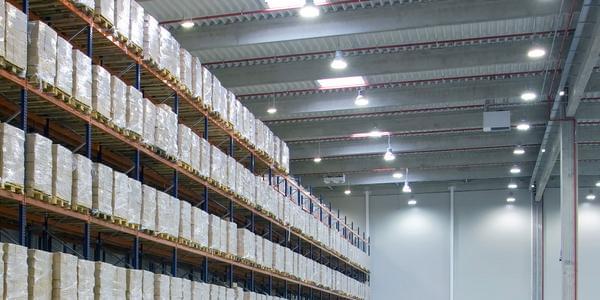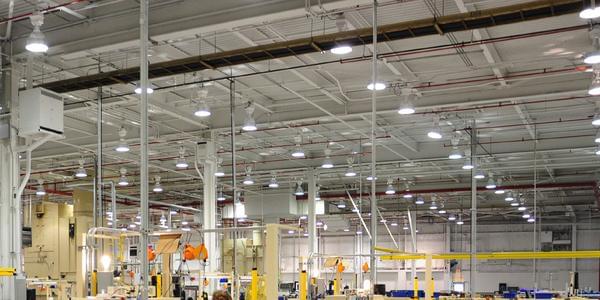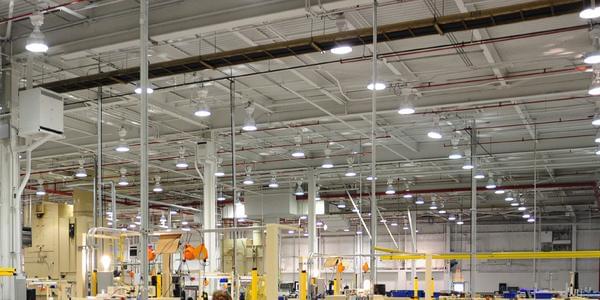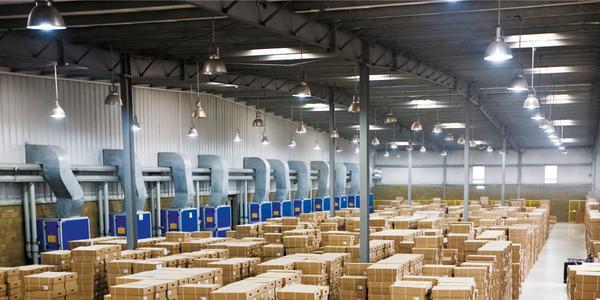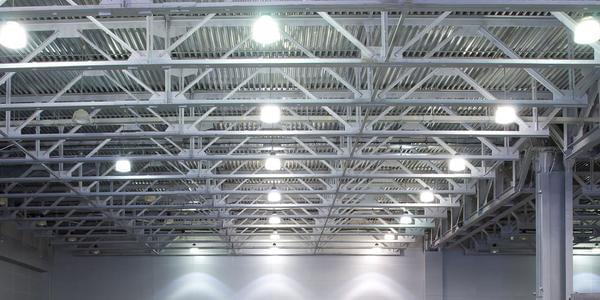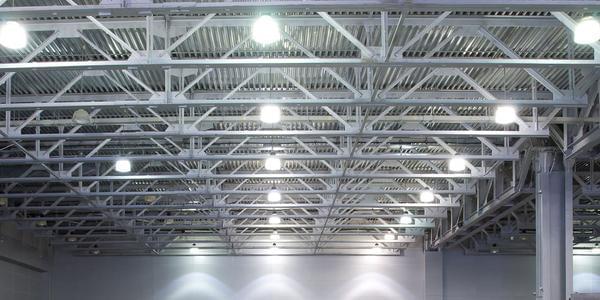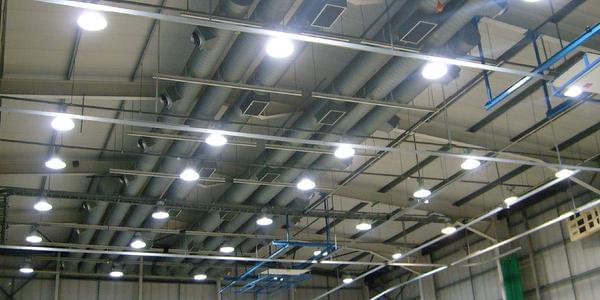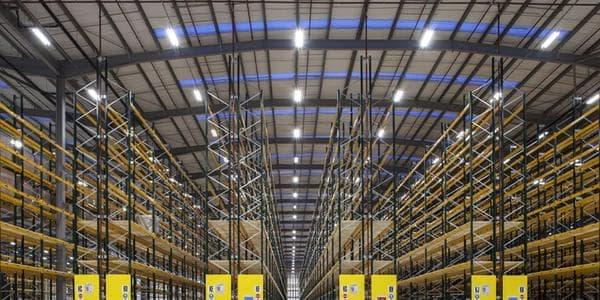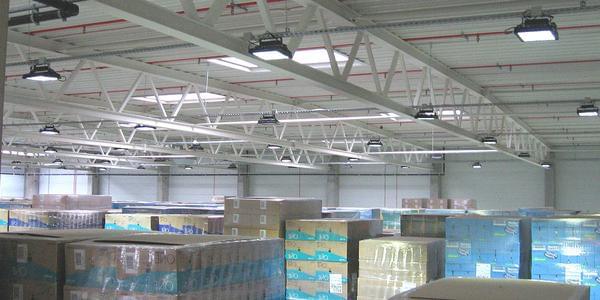We Supply & Install Energy Efficient Industrial LED Lighting Systems Across England & Wales
Save Up To 80-90% Energy - LED Factory Lighting UK - Bright White Light - 10 Year+ Lamp Lifetime - Lower Your Lighting Costs
What do we do?
We work across England & Wales to install Industrial LED lighting solutions in large commercial & industrial buildings (new installations & replacement of outdated low bay and high bay light fittings)
What type of industrial buildings are suitable for our LED lighting system upgrades?
This can include (but not limited to):
- Industrial units & factory buildings
- Manufacturing/assembly plants/ machine shops/ workshops, production/inspection & finishing areas
- Warehouse & storage buildings
- Other commercial buildings such as sports halls, aircraft hangars etc.
We would like a FREE factory LED lighting survey & quote - what next?
Please contact us HERE to arrange this
Our Energy Saving Industrial LED Lighting Installation Services - Design - Supply - Install
1 Do you need better, more efficient lighting in your commercial or industrial building?
Your existing lighting could be wasting your business many thousands of pounds every year, be difficult to maintain, or even produce inadequate light for your working conditions.
2 We install LED lighting systems across England & Wales!
Established in 2008 - we work across England & Wales as energy saving LED industrial lighting installation specialists - we supply & install energy saving LED (Light Emitting Diode) & other commercial & industrial lighting systems to save your business up to 80 % on lighting energy costs!
3 Contact us now to:
- Arrange a FREE, no-obligation lighting survey & energy report for your building
- Find out which of our energy saving lighting technologies is most suitable
- Get a quotation for a new lighting system (+ FREE Energy Savings Report)
- Learn about the financial incentives available (grants, tax relief schemes etc.)
Lighting
Design
Supply
Install
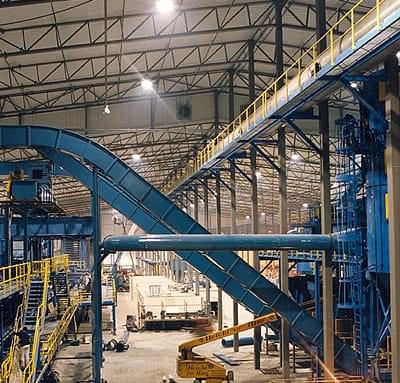
We work across England & Wales
Contact Us Now To Arrange A Free Consultation & Quote!
Use one of the following methods to contact the Green Business Light team:
You Can E-mail Us:
enquiry@greenbusinesslight.com
Or Call Us:
0333 344 6388
* We are TPS Registered
LED Factory Lighting Company UK
Or Complete The Simple Contact Form Below:
Please complete and we will be back in touch as soon as possible.
We Operate Across the UK
- North-West of England
- North-East of England
- East & West Midlands
- London & Home Counties
- South & South-West of England
- Wales
We Install & Commission Lighting for
- Large Commercial Buildings
- Warehouse & Storage Buildings
- Factories & Industrial Sites
- Logistics Depots
- Cold & Chilled Stores
- Sports Halls & Exhibition Centres
Using Latest Lighting Technologies
We replace 250W/400W sodium halide & fluorescent tube fittings with:
- LED Technology
- T5 Fluorescent Tube
- Induction Lamps
- Intelligent Control Systems
Our Frequently Asked Questions
Key questions to ask when specifying LED lighting for industrial buildings
Many businesses contact us about the installation of industrial LED lighting systems to replace existing 250/400W sodium & metal halide fittings with the primary intention of saving on energy and maintenance costs on their site. LED industrial lighting systems can certainly make exceptional savings but IT IS CRITICAL that LED light fittings are properly specified in factory and industrial buildings as these can present significant challenges.
Below are some key questions to be asked before deciding if an industrial LED lighting system solution is the right choice for factory and production buildings:
Can 250W/400W industrial lights be replaced one-for-one with LED factory lighting?
Larger industrial buildings (such as factories and production sites) typically have either low bay (a rectangular box housing at lower heights) or high bay light fittings (a domed housing at heights above 8 metres).
The light sources in the fittings are usually one of two HID (high intensity discharge) lamp types - high pressure sodium (a distinct yellow tinted light) or metal halide (white-blue tinted light) - usually rated at 250W or 400W powers
All of these HID light fixture types can usually be replaced by industrial LED light fittings but careful consideration must be given to the building conditions and the specification of the right light fixture.
Why is there a large variation in industrial LED light fitting costs?
The key thing to remember is that 'not all LEDs are equal' - at the moment the LED industrial lighting market is still relatively young - but growing rapidly as the technology becomes ever more efficient and the cost is reduced due to volume manufacturing etc. Every it year there are an increasing number of LED factory lighting suppliers.
The standardised costs of a typical HID (e.g. - sodium) industrial light is reflected by many years of market forces, regulation and their relatively simple constituent parts - namely:
- a lamp and connector
- ballast/control gear
- housing/reflector
However - a product from an industrial led lighting company can essentially be regarded as an electronic device comprised of a package of many individual electronic circuits & components (the failure of any one of these components will render the LED light inoperable).
When dealing with a LED factory lighting contractor you need to make decision between inexpensive industrial LED lights and a higher cost with an extended guarantee. We have heard of instances of poor quality, low-cost LED lights being stripped out of industrial buildings and replaced within 12 months
Do LED lights emit a 'cold' light colour?
The light emitted from some some industrial LED fittings can appear to be a blue tinted cool light - there can be several different reasons for this:
- Perception from previous lighting - if changing from older sodium HID light then LEDs will appear to be an improved light quality - however - if changing from fluorescent or metal halide lights then LEDs can appear to be a washed out 'pale' light - this can also be affected by the quality of the light fitting (see below)
- Quality of the LED fitting - Higher quality LEDs will emit a fuller light spectrum and be closer to around 5000K light colour temperature (daylight). Some LEDs can appear bluer either through choice or the fact it is easier to technically achieve a higher lumens per watt efficiency with a blue light colour.
Any LED factory lighting installer should take into account the incumbent lighting when deciding on how the new LED lighting will be perceived by the workers in the building
Do industrial LED lights provide an even light 'spread'?
The high height of light fixture positioning in large building can present challenges for the industrial LED lighting contractor with regard to obtaining an even distribution of light on the working plane. This is because the individual LED chips in a light fixture emit light as a direct 'beam' and require lenses positioned in front of them to spread the light & simulate a uni-directional light source (such as a 400W HID bulb). An incorrect specification of lens 'beam angles' can result in light "pooling" and dark areas around the internal space
Properly specified LED factory lighting solutions should avoid these issues with the correct lenses etc to provide an even distribution of light.
Are LED's suitable for all industrial environments?
A LED factory lighting installation may not be straightforward - some industrial environments present challenges such as vibration from large machinery, caustic chemicals, extreme temperatures, and power supply fluctuations, making it difficult to find lighting solutions that are suitable.
Some processes produce large quantities of dirt and debris which result in large volumes of air particulates being present - this includes:
- Foundries
- Metal casting and welding facilities
- Wood workshops
- Fine powder & particulate processes
This particular set of conditions results in accumulation of deposits onto light fittings. For LED fixtures this can be a particular problem as the top side of the LED fitting is typically a large aluminium heat sink which needs to be kept clean to effectively remove heat from the chip. Dirt also accumulates on the lens of the fitting - a dirt depreciation factor may have to be worked into calculations for light levels
If frequent cleaning with water jets will required then LED factory lighting solutions with the correct IP rating need to be specified (as is the case with any other type of industrial light fitting). There are also corrosion proof and explosive proof LED lights available for certain situations.
An industrial LED lighting supplier who understands your requirements for the specification of the correctly rated light fittings is absolutely crucial.
Are LED lights suitable for industrial environments with extreme temperatures?
Industrial processes can produce extremely hot environments - often exceeding average temperatures of 50°C (122 F). LED chips and driver electronics are extremely sensitive to high temperatures and there is the risk of accelerated lumen decay and increased premature failure rates.
Not every industrial led lighting company will have low bay or high bay LED lights that have been specifically designed for these types of conditions - specialist LED fittings will be necessary in these types of case.
How efficient are industrial LED lights?
LED lights can make very large savings in buildings but some of the claimed savings by unscrupulous LED sellers really push the boundary of what is possible without sacrificing light levels
It is impossible not to look at efficiency without examining the headline figures of lumens per watt output (also known as efficacy) for LEDs but this isn't the full story. The efficacy of a factory LED lighting fixture is a cumulative efficiency of its LEDs, heat sink, driver and optics. The system level efficacy of a LED luminaire is typically 25-30% less than the LED component due to losses from thermal, electrical and optical efficiency.For example, the LED component efficacy may be in the range of 140 – 150 lumens per watt, but after efficiency losses, the total system efficacy may be closer to range of 100 lumens per watt
LEDs are a rapidly progressing technology and they will be by far and away the most efficient type of light in the future. At the moment - they are on a par with the most efficient types of other lighting technologies (such as T5 fluorescent)
A general rule of thumb is that - to preserve existing light (lux) levels - energy consumption can be, at most, approximately halved from installation of new energy saving industrial lighting fixtures alone. Any further savings have to be made by control systems which adjust the light fixture power output for presence detection or existing daylight levels
A key aspect large open spaces of industrial buildings necessitate a much more evenly spread light with constant levels everywhere - a building such as a warehouse has the opportunity to adjust lighting levels in micro-zones (aisles, racking etc - as well as presence detection in these zones) which allows the very large savings to be made
Can industrial LED lighting be used with daylight control systems?
If there is sufficient access to daylight (via roof sky-panels etc.) - industrial LED lighting can be programmed to automatically adjust their light output levels in response to daylight entering the building during the different hours of the day (and times of the year) - this can provide additional savings which would not otherwise have been available with the older lighting system
Do LEDs have lower maintenance costs in industrial buildings?
Due to on-site machinery & equipment, hazardous processes or extreme heights industrial light fittings can be difficult to access for routine maintenance (e.g. - cleaning, lamp changes etc.) Industrial LED lighting fittings have a very long lifetime in comparison to other lighting options - 50000 hours plus is typical - which decreases the maintenance costs and other indirect costs such as necessary downtime etc.
Are there situations where LEDs have further advantages?
There are some industrial and manufacturing environments where LEDs enjoy key operational benefits over other energy efficient lighting choices (such as T5 fluorescent tubes, induction lamp etc.) - some of these are listed below:
- Cold and freezing environments - LED lights perform particularly well in low temperature environments - such as large industrial freezers and cold stores - one of the main limitations of an LED light is keeping the electronic s cooled - if the environment
- Food/pharmaceutical processing areas - LEDs contain no glass (to avoid the risk of contamination) as well as emitting much reduced levels of UV light which can help to reduce spoilage rates of fresh crops such as fruits, vegetables etc. during processing and packing stages and also with dealing with some chemicals
- Industrial buildings that experience regular power outages - In situations where areas of building frequently lose power (due to off-site or on-site electrical supply problems) LEDs have the ability to switch back on instantly at full brightness levels - there are no re-strike or warm up times
Getting a trial of LED lights?
If you are getting a trial or demonstration of new LED light fixtures from e.g. - an industrial LED lighting installer or electrical contractor - please note the following carefully:
- When looked at directly, working LED light fixtures will always appear very bright in comparison to standard light fixtures ( even if the industrial LED light is producing less total light output than surrounding standard fixtures). This effect is due to the fact that LEDs emit light from a much smaller source area (e.g. - an array of chips rather) compared to the larger total surface area of a lamp
- A lux meter should be always used to demonstrate that the lighting levels do not drop off rapidly from areas which are not directly below a proposed industrial LED light fitting.
Green Business Light provides a complete LED lighting supply and installation service for all types of industrial & factory buildings - contact us now to arrange a lighting survey and quotation...

